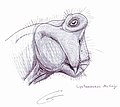Lystrosaurus
| Lystrosaurus Temporal range: Early Triassic
| |
|---|---|

| |
| Lystrosaurus murrayi | |
| Scientific classification | |
| Kingdom: | |
| Phylum: | |
| Class: | |
| Order: | |
| Suborder: | |
| Infraorder: | |
| Family: | |
| Genus: | Lystrosaurus
|
| Species | |
| |
Lystrosaurus (meaning 'shovel reptile', pronunciation in /ˌlɪstrɒˈsɔrəs/) was a genus of Early Triassic Period therapsids, which lived approximately 250 million years ago in what is now Antarctica, India and South Africa. It was a common synapsid, a group of animals ancestral to (and including) mammals, more frequently referred to as Mammal-like reptiles. More specifically it was a dicynodont (which means "having two dog-teeth", a characteristic of one sex, supposedly males). Lystrosaurs were heavily-built barrel-chested medium-sized (about a meter long) herbivorous animals, approximately the size of a pig, with very stout limbs. Their teeth had become reduced to two long tusks protruding from their upper jaws. Originally they were thought to be amphibious, a sort of small reptilian hippopotamus, but some more recent evidence indicates that they lived in arid environments, which were becoming increasingly common as the Triassic unrolled.
Dominace of the Early Triassic
Lystrosaurus is notable for dominating land during the Early Triassic, being found on every continent, for millions of years. This genus survived the end-Permian mass extinction and, in the absence of predators and other herbivorous competitors, went on to thrive[1], becoming the most common group of terrestrial vertebrates during the Early Triassic; for awhile 95% of land vertebrates were Lystrosaurus[2]. It is the only time a single species /genus of animal dominated the Earth to such a degree[3]. Lystrosaurus survived the Permian-Triassic extinction event due to its adaptation for subsisting on more resilient plant material and, possibly, by able to the breathe the Permian/Triassic noxious atmosphere due to burrowing and its barrel chest.[2]
Its discovery at Coalsack Bluff in the Transantarctic Mountains by Edwin H. Colbert and his team in 1969-70 helped confirm the theory of plate tectonics and convince the last of the doubters, for Lystrosaurus had already been found in the lower Triassic of southern Africa as well as in India and China.[4]
Lystrosaurus in popular culture
Lystrosaurus played a role in the BBC television series Walking with Monsters: Life Before Dinosaurs. One episode followed the journey of a group across a ravine and through a river full of the ancient crocodile relative Proterosuchus.
Notes
- ^ Michael J. Benton, When Life Nearly Died. The Greatest Mass Extinction of All Time, 2006, ISBN 050028573X
- ^ a b The Consolations of Extinction: includes section on Lystrosaurus and end-Permian extinction
- ^ BBC: Life Before Dinosaurs
- ^ Naomi Lubick, Investigating the Antarctic, Geotimes, 2005.
Gallery
-
Distribution of Lystrosaurus (brown) in the Gondwana supercontinent.
-
Lystrosaurus murrayi
-
Lystrosaurus georgi
-
Lystrosaurus mccaigi.




